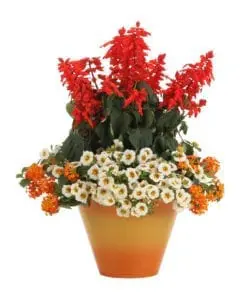Ultimate Guide for Taking Care of Your Flowers: Part 1
The right kind of care is essential to have flowers and plants to brighten up and add a fresh touch to your space. Even if you do not have a green thumb, you can learn how to take care of your flowers properly to make them bloom and last as long as possible.

The right kind of care is essential to have flowers and plants to brighten up and add a fresh touch to your space. Even if you do not have a green thumb, you can learn how to take care of your flowers properly to make them bloom and last as long as possible.
How to Keep Your Potted Flowers Healthy
A French novelist once said, “Every flower is a soul blossoming in nature.” Many people find great joy in cultivating and caring for their flowers and plants. In the sub-urban and rural areas, it is usually easy to grow flowering plants and bushes in the backyards. In highly urbanized areas, however, flowers and other plants can only be grown on rooftops or in small pots due to the limited space available.
Keep Your Potted Flowers Healthy
Here are some tips from Fiesta Flowers Plants & Gifts to ensure that your flowering plants will grow healthy and strong:
Choose a nutrient rich soil:
This is one of the first things you need to consider when growing potted flowers. Please note that commercially available potting soil is different in nutrient content from your ordinary backyard soil.
Garden soils that are not cultivated for long periods of time have poor structure and tilth. They are usually polluted with herbicides or pesticides and contain low amount of essential nutrients.
Potting soil, on the other hand, is fertile with many added nutrients and free from contaminants. It is specially formulated to provide flowering plants with the nourishment that they need. In addition, potting soil usually contains fertilizer which encourages plant growth. It is advisable to use a specially formulated potting soil instead of getting your soil directly from your backyard in order to nourish your flowering plants properly.
Water the plants regularly:
Like humans, plants need water to grow and survive. It serves as a medium for transporting nutrients from the soil to other plant parts such as the roots. It also keeps the cell turgid and drives important plant processes like photosynthesis.
It is important to note, however, that the water requirements differ from one plant to another. For example, Agave, Lantana, and Sedum do not require large amount of water to survive. Frequent watering is not a requirement for these plants. Meanwhile, Canna, Primrose, and Calla require lots of water to survive. You need to make sure that these plants receive enough water regularly.
In general, the best times to water the plants are in the mornings and evenings. Water the plants until the water leaks out from the bottom holes in the pot. In this way, you can be sure that the water has reached all the layers of the soil.
Perform deadheading:
This is the process of eliminating dead flower heads in the plant to allow further flowering. During the process, the dead parts are manually cut to prevent the other parts from wilting.
Deadheading is also performed to encourage new flowers to grow. It prevents the wilted petals from scattering around the base of the plants as well.
Apply fertilizer:
The overall nutrient content of the soil diminishes through time. This is because plants consume these nutrients for growth and flowering. If the nutrients in the soil are not sufficient, the plant may start to develop diseases.
Plant disease can be prevented by feeding the soil regularly with fertilizers that are rich in Nitrogen, Phosphorus, and Potassium. These fertilizers are available in solid and liquid forms. Liquid fertilizers are mixed with water while solid fertilizers are applied directly into the soil.
During watering, these fertilizers may leach out easily. This is why it is important to follow the directions carefully with regards to the frequency and the amount of application.
Expose the plants to light:
Light is an essential factor in the food making process in plants. Without it, the plant may not produce the energy it needs for growth and development. It also affects the flowering of plants in a process called Photoperiodism or the response of plants to the length of daylight.
Some plants need long exposure to sunlight for them to flower. These are called long-day plants. Examples of this type include Asters and Coneflowers. On the other hand, plants like Chrysanthemums, Christmas Cactus and Poinsettias need shorter exposure to daylight for them to flower. These are called short-day plants.
It is important to know the daylight requirements of the plants for them to have full-grown flowers. Not taking this factor into consideration may cause early senescence and death.
Fiesta Flowers Plants & Gifts offers many indoor plants to choose from for yourself or for your loved ones. Why not start your own indoor garden to give your home a touch of green?

